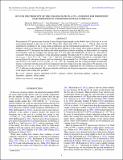HST-COS SPECTROSCOPY OF THE COOLING FLOW IN A1795—EVIDENCE FOR INEFFICIENT STAR FORMATION IN CONDENSING INTRACLUSTER GAS
Author(s)
Roediger, Joel; Veilleux, Sylvain; Ehlert, Steven; McDonald, Michael A.
DownloadMcDonald-2014-HST-COS SPECTROSCOPY.pdf (602.9Kb)
PUBLISHER_POLICY
Publisher Policy
Article is made available in accordance with the publisher's policy and may be subject to US copyright law. Please refer to the publisher's site for terms of use.
Terms of use
Metadata
Show full item recordAbstract
We present far-UV spectroscopy from the Cosmic Origins Spectrograph on the Hubble Space Telescope of a cool, star-forming filament in the core of A1795. These data, which span 1025 Å < λrest < 1700 Å, allow for the simultaneous modeling of the young stellar populations and the intermediate-temperature (10[superscript 5.5] K) gas in this filament, which is far removed (~30 kpc) from the direct influence of the central active galactic nucleus. Using a combination of UV absorption line indices and stellar population synthesis modeling, we find evidence for ongoing star formation, with the youngest stars having ages of 7.5 [+2.5 over -2.0] Myr and metallicities of 0.4 [+0.2 over -0.1] Z[subscript ☉]. The latter is consistent with the local metallicity of the intracluster medium. We detect the O vi λ1038 line, measuring a flux of f[subscript O VI, 1038] = 4.0 ± 0.9 × 10[superscript −17] erg s[superscript −1] cm[superscript −2]. The O vi λ1032 line is redshifted such that it is coincident with a strong Galactic H2 absorption feature, and is not detected. The measured O vi λ1038 flux corresponds to a cooling rate of 0.85 ± 0.2 (stat) ± 0.15 (sys) M[subscript ☉] yr[superscript −1] at ~10[superscript 5.5] K, assuming that the cooling proceeds isochorically, which is consistent with the classical X-ray luminosity-derived cooling rate in the same region. We measure a star formation rate of 0.11 ± 0.02 M[subscript ☉] yr[superscript −1] from the UV continuum, suggesting that star formation is proceeding at13 [+3 over -2]% efficiency in this filament. We propose that this inefficient star formation represents a significant contribution to the larger-scale cooling flow problem.
Date issued
2014-08Department
MIT Kavli Institute for Astrophysics and Space ResearchJournal
Astrophysical Journal. Letters
Publisher
IOP Publishing
Citation
McDonald, Michael, Joel Roediger, Sylvain Veilleux, and Steven Ehlert. “HST-COS Spectroscopy of the Cooling Flow in A1795—Evidence for Inefficient Star Formation in Condensing Intracluster Gas.” The Astrophysical Journal 791, no. 2 (August 6, 2014): L30. © 2014 The American Astronomical Society
Version: Final published version
ISSN
2041-8213
2041-8205